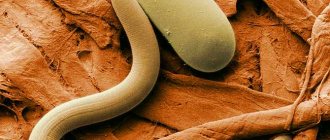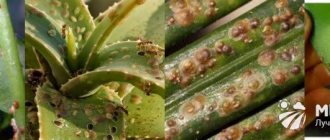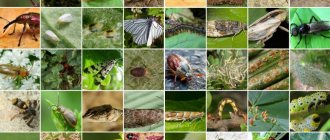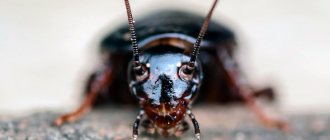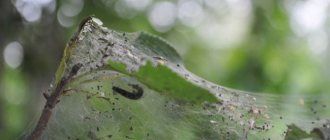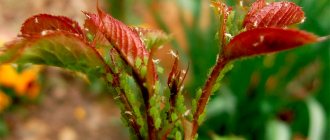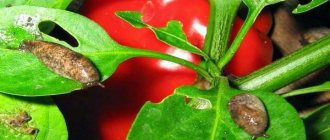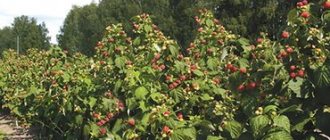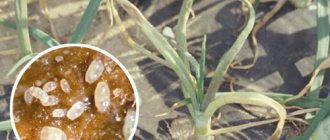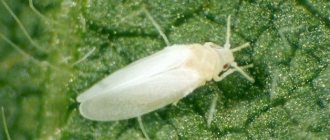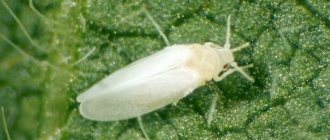It’s not for nothing that potatoes are called the second bread. Plantings of this plant can be found in almost every summer cottage or garden plot. It is all the more important to know which insect pests pose a particular threat to your favorite tubers.
And also instructions on how to use preventive measures to prevent the appearance of the “enemy” in potato beds and what effective methods to combat flying and crawling tuber lovers. This is exactly what our article is about today.
Colorado beetle
The first place in the list of “enemies” of potatoes is occupied by the Colorado potato beetle. The striped orange-black insect is familiar to many summer residents for its gluttony. Having settled on potatoes, the beetle and its larvae feed on the leaves and shoots of the crop, leaving behind gnawed stems.
On a note! The pest is dangerous for all plants of the nightshade family: tomato, physalis, sweet pepper, eggplant.
The size of adult individuals (imago) does not exceed 12 mm, larvae reach 10-15 mm. Orange-colored caterpillars with a black head and two rows of black dots on the sides emerge from clutches of eggs in early summer. In their development, they go through four stages (ages), then they go into the soil and pupate.
Females lay from 300 to 750 eggs per season, the number depends on weather conditions and climate characteristics. Adult larvae crawl over plants in search of food, gradually capturing new areas of potato plantings and eating healthy bushes. Thanks to their wings, beetles fly considerable distances in search of food.
Pests are most active during the period of budding and flowering. If left unchecked, insect colonies can completely destroy potato plantings. It is difficult to fight the beetle, since the insects are resistant to chemicals and can go into diapause (hibernation) for 2-3 years, experiencing periods of hunger. Insects sense danger and at critical moments fall to the ground, pretending to be dead.
Birds, with the exception of turkeys and guinea fowl, are not interested in Colorado beetles, since a significant amount of dangerous toxins (solanine) accumulates in the cells of the pest’s body. Natural enemies that are dangerous to the larvae are ground beetles and ladybugs.
Common potato pests
Colorado beetle
The Colorado potato beetle is the most common and dangerous potato pest. It is voracious and causes significant damage to the crop. In addition, adults are capable of flight, so they can travel long distances and infest many plantings.
The Colorado potato beetle is a member of the leaf beetle family. This pest has an oval body, the length of which varies between 8-15 mm and width - 7 mm. The abdomen is orange in color with black spots. Hard elytra are adjacent to the body of the pest. This beetle has three pairs of legs.
Both larvae and adults of the pest feed on the leaves of cultivated and wild nightshade plants. In addition to potatoes, they eat leaves of tomatoes and eggplants, and bell peppers.
Adults overwinter in the soil, at a depth of about 50 cm. After wintering, they come out and begin to feed and mate.
Females lay eggs on the underside of potato leaves. During the season, one female Colorado potato beetle lays about 350 eggs. Larvae emerge from the eggs. This happens 1-2 weeks after laying. Everything depends on weather conditions.
The larvae, like adult beetles, eat potato leaves, leaving only the stems. Having destroyed the tops of one plant, the pests move to another.
The lifespan of this pest is 1 year, but some individuals live up to 2-3 years.
Birds that destroy insects are not able to fight this pest. This is due to the fact that many toxic alkaloids accumulate in the bodies of Colorado potato beetles - this makes them inedible.
These pests are capable of destroying the entire potato crop, as they are very voracious. Colorado beetles can consume not only young stems, but also ripe tubers.
Caterpillars
Caterpillars can also cause damage to potatoes. This is a potato scoop. The caterpillars of this butterfly prefer moist soil, as well as shaded areas. The caterpillar appears on the potato stem in late April - early June.
Cutworms are predominantly nocturnal. Caterpillars belong to the group of polyphagous pests: they feed not only on potatoes, but also on carrots, onions, and some other crops.
The greatest damage is caused by the potato cutworm caterpillar in rainy years, at moderate air temperatures.
The potato cutworm is light yellow or bright red in color, its head is red, without a pattern. Body length is about 5 cm. It has 8 pairs of legs. The caterpillar infects the area above the root collar. The plant on which the cutworm has settled quickly dries out and withers.
Caterpillars penetrate inside the potato tuber, gnawing the stem of the bush. Thus, the entire plant suffers.
Caterpillars usually do not damage potato skins. They make a small hole and passage, at the end of which they initially form a small, but constantly increasing in size, cavity, which is gradually filled with excrement. When the cutworm finishes feeding, it leaves the tuber, making a new, wider move. Potatoes damaged by the caterpillar usually rot due to secondary infection.
Medvedka
The mole cricket is an orthoptera insect whose body reaches up to 5 cm in length. The body is large, dark brown in color. The mole cricket has short wings and powerful legs, with the help of which it can burrow deep into the ground. This insect also has strong jaws and long whiskers.
An adult mole cricket makes a nest not too deep underground, which it fills with eggs. After laying, hundreds of 2-3 mm larvae hatch. They grow for several years, after which they begin to lead a full-fledged lifestyle.
The mole cricket poses a danger to all plants that come across its path. It harms not only potatoes, but also cucumbers, beets, cabbage, and grains.
The insect has a spindle-shaped abdomen and a head with large eyes. There are two pairs of tentacles around the gnawing mouth. The insect reproduces in the ground, laying up to 250 eggs at a depth of 15 cm or more.
Not only adult mole crickets, but also their larvae pose a danger to potatoes. They chew through the stem, causing it to fall or dry out and stop developing. The mole cricket is also capable of gnawing large cavities in tubers.
Most often, the mole cricket completely eats up the root crops. Even those potatoes that were simply “eaten up” by a mole cricket are unsuitable for food.
Wireworm
The wireworm is a pest whose danger is comparable to that of the Colorado potato beetle. It belongs to the beetle family. The length of its body reaches 7-20 mm.
Externally, wireworms are the larvae of click beetles with a finger-like process directed backwards.
The adult is a black beetle with an elongated body.
One female is capable of laying up to 150 eggs. The larvae hatch after 20-40 days. They grow and develop over 3-4 years.
In the first year, the larvae do not pose a threat to cultivated plants, but in the next 3 years they become more active and are able to eat the seeds even before they sprout.
Wireworms cause great harm to potatoes. They destroy seeds and shoots, gnaw roots and stems, and penetrate root crops and tubers. Because of this, the potatoes begin to rot.
Wireworms actively eat potatoes if the weather is hot, there is not enough moisture, and also if they lack wheatgrass roots, which are the favorite food of this pest.
Nematode
The golden potato nematode is a microscopic pest that is the causative agent of the disease globoderosis.
The nematode lives in the soil, remaining active for up to 10 years. The pest survives the winter in the form of larvae and eggs in cysts.
In the spring, the eggs develop into larvae that penetrate the roots of the plant. Here they develop until they become sexually mature females and males.
Females tear apart the roots, partially remaining inside the plant. After fertilization, they lay eggs inside their own body. When the eggs mature, the female's body dies and the eggs remain inside it. When harvesting potatoes, the cysts fall off and penetrate the soil. The development cycle repeats.
Nematode under a microscope
Potato flea beetle
The potato flea beetle in adulthood is a beetle up to 3 mm long. The main color is black, the limbs have a dark brown tint.
The flea beetle harms potato tops. Larvae developing on roots can cause the loss of healthy bushes. If optimal conditions for the development of the pest are present, a significant part of the crop is spoiled.
Potato flea beetles leave pits and holes on the surface of leaves. Adults eat foliage. If it was severely affected, then the potato seedlings die, especially if the planting was late.
Potato flea beetle larvae inhabit the root system of various nightshade plants: not only potatoes, but also tomatoes and eggplants.
The potato flea beetle causes the greatest damage to bushes if it is a warm and humid year.
This pest is a carrier of many infectious potato diseases.
Potato moth
This butterfly can destroy up to 80% of the crop. It has a small size, reaching 6-8 mm in length. In summer, the development process from egg to adult takes up to 4 weeks.
Potato moth is unpretentious to external conditions. The butterfly lays eggs on the bottom of the plant leaves. A clutch usually consists of 1-20 eggs. The eggs hatch into caterpillars, which later turn into butterflies.
The potato moth feeds on the underside of the potato leaf. When the tops dry out, the pest moves to the tubers. Through the eyes and cracks on their surface, the moth penetrates inside and feeds on the pulp.
Potato moth weakens potato bushes, damages tubers and reduces the quality and quantity of seed.
Potato aphid
This pest belongs to the order Hemiptera. These are small insects, their body length reaches 3.5 mm. Among them there are both winged and wingless individuals. The pest is found everywhere.
The body is shiny, elliptical in shape, color ranges from white-green to yellow-green.
The mouthparts of these insects are adapted for piercing tissues and sucking juice from plants. Because of this, damaged potato leaves dry out, the crop stops growing, and productivity decreases.
A characteristic feature of these pests is that they leave sugary secretions in the places from which they have absorbed juices. These secretions attract other pests, creating favorable conditions for the development of fungi. In this case, the crop completely dies due to the invasion of various insects.
Aphids reproduce very quickly in dry, warm weather. The number of aphids is significantly reduced if there is a ladybug on the site.
Chafer
May beetle larvae can also cause damage to the potato crop.
The cockchafer appears in late April – early May. One female lays up to 70 eggs in the ground. After a few weeks, the larvae appear. In the first year, they feed on organic debris, enriching the soil with waste products and benefiting the soil. In subsequent years, the larvae develop a chewing apparatus, thanks to which they are able to eat potato roots and tubers.
The larvae are located in the upper layers of the soil, at a depth of 20 to 40 cm.
With a high concentration of larvae in the soil, a large number of potatoes are destroyed. Even one larva at the age of 3-4 years can damage several dozen tubers in just a few weeks.
It is quite simple to determine that the potato was affected by the larva of the cockchafer: if the leaves wither, dry out and turn yellow for no apparent reason, then this is the result of the activation of this pest.
Slug
Naked slugs do not often attack potatoes, but they can still cause damage.
Their body length, depending on the species, can reach 3-6 cm. They are most active at night. For them, places with high humidity are most attractive.
Slugs attack the foliage and tubers of potatoes. They chew irregularly shaped holes in leaves. They leave only the stem and the largest veins intact.
Crawling from one plant to another, slugs spread fungal and viral diseases. If they damage potatoes, late blight develops.
Rodents
Certain types of rodents also pose a danger to potatoes. Often this crop is spoiled by the mole rat, an animal that resembles a mole. Instead of eyes, he has a fold of skin covered with stiff stubble. It feeds only on root vegetables and does not eat insects. The mole rat eats large potatoes on the spot, and drags small ones into a hole.
The ground rat also gnaws potato tubers. It can be seen on land plots that are located next to bodies of water. It penetrates 15-25 cm underground and chews root crops. In addition to damaging the crop, the rodent disrupts the root system of plants, which leads to their drying out and reduced yield.
The earth rat also creates pantries underground in which it hides food for the winter. The depth of such warehouses is about 20 cm. This rodent is very prolific and breeds many new pests in a short time.
Cicadas
Cicadas are small insects (1-3 cm), which are similar to jumping butterflies. During the day they live in anthills, and at night they come out to drink plant sap.
Cicadas reproduce very quickly: it only takes 20 days for an egg to develop into an adult. Their widespread distribution throughout Russia was facilitated by the import of plants from abroad.
By sucking the juice from the leaves of cultivated plants, leafhoppers cause damage to them: this leads to a slowdown in development and growth cessation, as well as the death of part of the potato bush.
Potato leaves damaged by leafhoppers turn yellow and become deformed, and white or red spots appear on their surface. Bacteria and fungi easily penetrate through damaged areas, causing the development of various diseases.
Cicadas can also act as carriers of viral diseases. These pests infect plants with poisonous saliva and lay eggs. Both adults and larvae pose a threat to plants.
Nematodes
The worst pest of potatoes (see photo) is the microscopic golden nematode. The worms, about 1 mm long, live in the soil for about 8-10 years. They overwinter as eggs and larvae in cysts, and when warmer, they penetrate into the root system of plants. Feeding on plant tissues and juices, they grow to adult individuals, which, after fertilization, lay eggs inside themselves and then die. There are several types of nematodes:
- gall - damages the roots of the crop, potatoes in the ground;
- stem - affects the ground part of plants, appears on tubers during storage;
- soil - parasitizes the roots of potatoes.
When affected by a nematode, the bushes stop growing and turn yellow. During the flowering phase, the buds are small or absent, tubers are not formed. The pest appears when agricultural practices are violated, there is no crop rotation on the site, or when planting infected seed material
Wireworm and false wireworm
The damage caused by the wireworm is comparable to the damage caused by the Colorado potato beetle. Wireworms are the larvae of the click beetle, which are omnivorous and damage all garden crops and cereals. Adults are not dangerous.
The larvae are caterpillars up to 2-3 cm long, with a hard chitinous covering of brown-yellow, brown color. They live in the soil for 3-4 years, damaging roots, stolons, and the lower part of plants. The larvae gnaw labyrinthine passages in the tubers, causing potato rot and spoilage. Pests carry viruses of dangerous diseases; potatoes are unsuitable for storage and food.
On a note!
The favorite plant of wireworms is wheatgrass, and the largest reserves of beetle larvae are located on land plots overgrown with this weed.
False wireworms are the larva of the darkling beetle and are very similar in appearance to real wireworms. The differences are in the life cycle, as these pests live for about a year. Plants are damaged by adult individuals, as well as worm larvae, which eat up seed embryos, roots of seedlings and stems near the root collar.
Aphid
The worst potato pest, the aphid, is found in all regions. In nature, there are hundreds of varieties of this insect, differing in biological parameters. The potato aphid is a small insect, about 2-3 mm in size, greenish in color with a dark head. There are individuals with and without wings, each group has its own functionality (reproduction or movement).
Insects feed on plant sap and live in colonies on the underside of leaf blades. When potatoes are damaged, the upper tier of leaves begins to curl and dry out. The bushes wither, which reduces the crop yield. Aphids secrete honeydew, which the ants feed on and attracts flies. Sooty fungi quickly form on the leaves.
This species of aphid is polyphagous, feeding on the sap of a wide variety of crops. With a massive invasion of aphids, the threat hangs not only over potato beds, but also over plantings of tomatoes, eggplants, cabbage, cucumbers, zucchini, and roses. The danger of the pest also lies in the fact that aphids spread a large number of different viruses, infecting healthy potato plantings.
Cicadas
Most of the leafhoppers live in the southern regions of the country. The insects are similar in appearance to aphids, but have well-developed hind limbs. Thanks to their legs, tiny cicadas jump, and their wings allow them to fly around the entire site. They switch to potatoes from weeds (bindweed, thistle), and feed on the juice of the leaves of the crop.
In the south, potatoes are affected by the following types of leafhoppers:
- white;
- green;
- bindweed.
The main danger lies in the transmission of various diseases by leafhoppers, including the insidious mycoplasma infection – potato stolbur.
Potato spandex
Typically, this pest lived in the southern regions of the country, but due to climate warming, it began to be found more and more often in the middle zone and in the southern regions of the European North. The oblong-shaped bugs reach a length of 1.5-2 cm and fly across the area, damaging the foliage of various crops. Up to 10-15 bugs usually gather on a potato bush, completely eating up the above-ground part of the plant. In 2-3 days, only stems remain from the bush.
The period of activity of the spanka occurs in the middle of summer, when it is hot in most parts of the country. The larvae do not cause harm; the danger comes from adults that eat potato tops. Manual collection of the pest is not practiced, since the body contains a caustic toxic substance - cantharidin. If it comes into contact with the skin, it causes redness, abscesses, and ulcers. If the poison enters the blood through wounds and damage, it causes poisoning.
Insecticides
Insecticides are poisonous drugs used in pest control. When choosing a product, look at the information on the packaging. The following data must be included: active substance, manufacturer's address and exact instructions. If there is no such data, do not take the drug, it may turn out to be a fake.
Preparations that destroy the Colorado potato beetle and soil-dwelling pests
- Commander, VRK (water-soluble concentrate) - a means of contact-intestinal action. Used for spraying and application to the soil. The protective period lasts from 15 to 30 days. Moderately hazardous substance. Toxic to bees.
- Tanrek, VK (water-soluble concentrate) is a contact-intestinal preparation for spraying and soil treatment. Protective effect - 14 - 21 days. Moderately dangerous. Toxic to bees, earthworms and birds.
- Prestige, KS (suspension concentrate) is intended for dressing tubers before or during planting. The period of protective action is 30 - 40 days. Moderately hazardous substance. Highly toxic to bees.
- Aktara VDG (water-dispersible granules), KS (suspension concentrate). The product is used for soil treatment and spraying. Insects die after 24 hours. Moderately dangerous drug. Toxic to bees.
Table: plant protection products against pests
| Colorado beetle | |
| Drug name | Description |
| Agravertine EC (emulsion concentrate) | Biological product with enteric contact action. Adult beetles and larvae die after 2 - 5 days. Refers to moderately dangerous drugs. |
| Aktofit, EC (emulsion concentrate) | Biological product. Dangerous for bees. Toxic to cold-blooded people. Make sure that the drug does not get into water bodies. Insects die 2 - 3 days after spraying the plant. Moderately hazardous substance. |
| Karate, CE (emulsion concentrate) | Contact preparation for spraying plants. Moderately hazardous substance. The death of pests occurs within 24 hours. The drug is low-toxic for birds, dangerous for cold-blooded animals and bees. |
| Fitoverm, EC (emulsion concentrate) | Biological product. The effect of the product lasts 7 - 20 days. Substance of moderate danger. Moderately toxic to bees, dangerous to cold-blooded bees. |
| Golden nematode, wireworm, mole cricket | |
| Drug name | Description |
| Grom-2, G (granules) | Preparation for underground pests. Insects die within 3–5 days. The protective effect lasts 25 - 30 days. Moderately dangerous. Toxic to cold-blooded people. |
| Bazudin, G (granules) | Insecticide of contact, intestinal action. Designed for application into holes during planting. The death of the insect occurs the next day. Protective effect - 35 - 45 days. Means of medium danger. Highly toxic to cold-blooded animals. |
| Marshall, EC (emulsion concentrate) | Designed for application to the soil and spraying. The pest dies instantly. When tilling the soil, the protective effect lasts 40 days, when spraying - 21 days. Absorbed by leaves, roots, distributed throughout the plant. Dangerous product. Not recommended for use due to high toxicity. |
| Pochin, G (granules) | Contact means. Protects the root system. Insect poisoning occurs within 24 hours. Moderately hazardous substance. Toxic to cold-blooded people. |
When working with poison, carefully follow the instructions. Don't forget to protect yourself by wearing protective clothing, a respirator, and safety glasses.
Potato moth
A small gray-brown butterfly lays eggs in the soil, on the back of leaves, in storage, from which voracious larvae then emerge. It is they who pose a danger to potato tubers, and in plantings - to the leaves and shoots of the crop.
The larva is yellow or off-white in color, about 1-1.5 cm long, and eats potatoes in the ground. Biting into tubers, it leaves numerous convoluted passages, as well as excrement. Potato moth can be detected by a number of signs:
- eaten leaves of tops;
- withering tops of bushes;
- dry or wet rot;
- passages in potato tubers.
On a note!
Potato moth also damages tomatoes, eggplants, and sweet peppers.
Why plant other crops next to potatoes?
Other plants near potatoes are good helpers in the fight against various pests. Firstly, if these plants have a strong odor, then they interrupt the smell of potatoes, which insects flock to. They have already been discussed above. Secondly, some of them enrich the crops planted next to them with certain nutrients. Thirdly, there are plants that do not allow pests to live even underground, for example, mustard. She would like to pay special attention.
Mustard is an enemy of underground pests
Mustard not only keeps wireworms and slugs away from potatoes, but also disperses weeds, suppresses late blight and retains moisture in the soil.
Mustard must be cut as soon as it reaches the potato bush
Green fertilizer is sown densely in row spacing in 1 - 2 rows of 300 g of seeds per hundred square meters. Planting depth is 3 cm, then the seeds are sprinkled with soil, watered abundantly and mulched. When the mustard is equal to the potato bush, it is cut off. So, it will not interfere with the development of the main crop, and the yield will not decrease.
Spider mite
A very tenacious insect, reaching a size of about 0.6-0.8 mm. It feeds on plant sap and lives on the underside of leaves. Under normal conditions, it produces one generation per season, but in shelters where seed potatoes are grown, up to 4-5 generations of the pest emerge.
Leaves damaged by mites become covered with yellow or brown specks, and the tops wither and dry out. A characteristic sign of the presence of a mite on potatoes is a silvery small cobweb entwining the underside of leaves and flowers.
Potato cutworm
An inconspicuous gray butterfly is capable of destroying potato plantings over a large area. Female pests lay up to 60-70 eggs, from which caterpillars emerge in late spring. The potato bollworm is an insect from the group of polyphages, in addition to potatoes, it damages plantings of carrots and onions.
Yellow or red-brown larvae reach a length of 5 cm and penetrate into the tubers inside the stem of the bushes. Due to the fact that the roots are eaten away, the tops wither and the bush quickly dies. The cutworm makes its moves in potato tubers, feeding on the tissues of the vegetable and leaving excrement in the cavities. After filling the cavity, the larva moves to another tuber. Damaged tubers rot, leading to serious crop losses.
Final table
| Pest | Means |
| Colorado beetle | Aktara, Zhukoed, Komandor, Regent, Kinmiks, Golden Spark, Fitoverm, dusting with gypsum or cement chips, soap-ash and vinegar-soda solutions. |
| Potato scoop | Bazudin, Nemabact, Karbofos, Iskra, Alatar, Tod, Decis, Actellik, Zolon, Tsimbush, Lepidotsid, Danadim, Bitoxibacillin, wormwood decoction. |
| Medvedka | Medvetox, Grizzly, Rubezh, Medvecid, Thunder, Phenaxin plus, Bankol, Metaphos. |
| Wireworm | Prestige, Taboo, Nuprid, Matador max, Force, Bazudin, Provotox, Nemabact. |
| Nematode | Force, Vidat 5 G. |
| Potato flea beetle | Prestige, Decis, Konfidor, Mospilan. |
| Potato moth | Aktara, Zhukoed, Fitoverm, Commander, Decis, Bi-58, Fastak, Arrivo. |
| Potato aphid | Aktara, Iskra, Commander, Karbofos, Imidor, Metarizin, Aktofit, tobacco tincture. |
| May beetle (Khrushchev) | Bazudin, Pochin, Metarizin, onion and garlic infusions. |
| Cicadas | Aktara, Aktellik, Bi-58, Akarin, 30% karbofos solution. |
| Onion root mite | Tagore, Kinfos, Bi-58. |
| Slugs | Slug Eater, Thunderstorm, Metaldehyde. |
Potato flea beetle
Tiny black bugs were first discovered in the United States, then they moved to other continents. In Russia they are found everywhere, right up to the Far East.
The sizes of imago are from 2 to 2.8 mm, larvae are up to 12 mm. The caterpillars are white in color, emerge from eggs in underground clutches, and feed on potato roots. Adult beetles are leaf beetles and eat leaf blades on bushes. After an invasion of flea beetles, the potato leaves are covered with numerous holes and look like a sieve. Plants stop growing, dry out, and productivity decreases sharply. In addition, flea beetles spread viruses that infect weakened crops.
Black-headed spandex: photo and description
An adult spanka has a size from 12 to 22 mm, a black body, and a red head with black eyes and a mouth. There is a dark stripe with white hairs on the top of the head, and the whiskers are black with a red tip. The wings have a characteristic white border consisting of white fibers.
On a note!
The popular name of the beetle is “Spanish fly”.
Black-headed spandex
The main diet of pests consists of green parts of wild and garden plants. Settling in the beds, the spanka eats potato leaves, young shoots and even flowers, using powerful chewing blades. Scientists consider these beetles to be companions of locusts, since their appearance on garden crops often occurs after their previous invasion. Shpanks are parasites whose larvae develop in the capsules of orthopteran insect species (locusts).
Pests begin to fly at the end of May and continue their active lifestyle until the beginning of August; they are especially numerous on hot days. They easily move between forest and park plantings, choosing a suitable tasty lunch for themselves along the way. After finding one, they sit on the branches of a food plant (lilac, poplar, vegetables) and gnaw the leaves.
During its flight, the black potato beetle emits a pungent, unpleasant odor. In the evening hours and at night, the beetles are in a state of rest - they sit motionless and wait for the morning. The lifespan of the pest is 2-4 months.
Reproduction of spanks occurs as follows: the female lays eggs in burrows dug in the ground at a shallow depth (up to 2.8 cm), 40-50 elongated yellow testicles up to 6.5 mm in size. Then it compacts the soil. The process of egg development lasts 23-38 days.
Then, smart, brown, flat-shaped larvae (tringulines) with long white legs emerge from them. With their help, they actively search for egg capsules of orthopteran insects (locusts, etc.), which can last up to 2 weeks. They then settle and feed inside them for 4-10 days. As the larva develops, it goes through several stages of growth. Having destroyed all the eggs, she gnaws a hole and crawls into the ground, where she goes through the molting stage. The larva turns into an orange false pupa with a hard shell and short legs.
Black-headed Spaniard
With the onset of cold weather, the larvae of the larvae begin to burrow into the ground to a depth of 40 cm; they survive the winter in the false pupa stage. By April, they begin to get closer to the surface of the earth and pupate.
The distribution area in Russia is in the regions of the Far East (Amur Region, Primorsky Krai, Altai and Transbaikalia), as well as in Asian countries (Japan, Korea, China and Mongolia).
On a note!
However, in recent years, due to changes in climate, the black-headed spank began to appear in the regions of the European part of Russia - it was discovered by gardeners in the Middle and Lower Volga region, Southwestern Siberia, etc.
Potato ladybug
The scientific name is epilyachna, it looks like a ladybug, but the body is covered with whitish hairs and the number of black dots on the wings is much larger (28 spots).
A 4-5 mm beetle lays eggs on the lower surface of the foliage. In one litter there are up to 20 copies, while the total number of eggs per season can be about 300-500 pieces. The larvae are yellowish-green with numerous black fibers and eat leaf pulp. Caterpillars and adults leave only the veins of the plates, completely eating away the soft tissue.
Plants dry out, wither, and tuber formation stops. The cow is a carrier of dangerous viruses, which increases the damage caused by insects to garden plantings. In addition to potatoes, it damages tomato bushes, peppers, young shoots of cucumbers, pumpkins, and corn.
Slugs
The harm of this inconspicuous nocturnal mollusk should not be underestimated. Gastropods parasitize on beds with potatoes, carrots, and beets, preferring wet areas.
Slugs gnaw through the tissues of leaf plates, leaving holes and silvery marks on the surface, and damage roots and tubers. By doing this, they spoil the presentation of vegetables, reduce the quality and keeping quality of the crop. Mollusks carry parasitic helminths and pathogen spores, infecting not only plants on the site, but also domestic animals.
Wireworms in potatoes: how to get rid of them
These are beetle larvae that can reside and develop in the soil for several years. Under favorable conditions, the larvae awaken and begin to destroy the crop (Figure 3).
Figure 3. Symptoms of wireworm damage
Insects are especially active when the soil is insufficiently moist. They penetrate roots and tubers, gnawing holes in them, reducing the quality of products and making plants more susceptible to disease.
Medvedka
A large, menacing-looking insect (up to 5-6 cm) with a dark brown body, strong legs and powerful jaws. The mole cricket lives in the soil, making numerous passages and laying eggs. Harm is caused by imagoes and mole cricket larvae:
- gnaw plant stems;
- eat root crops;
- damage potato tubers.
You can find out that a mole cricket has settled on the site both by damaged, withering bushes and by holes with heaps of earth on the soil surface (insect exits).
Prevention of potato pests
Vegetable growers have to constantly fight potato pests. But prevention is the most effective option against potato parasites on the site. You need to start protecting the crop with planting material. There is a large selection of drugs. They differ in their operating principle, price, volume, and degree of danger. Ways to use protective equipment:
- Processing potato tubers before planting. You can take “Prestige” or “Taboo”. The drug is applied directly to the tubers or the solution is added to the wells. A solution of potassium permanganate or wood ash is a substitute for chemicals.
- Deep plowing of the site in the fall. This technique destroys the larvae of pests that have gone to winter.
- Hilling up, high-quality weeding of potatoes. Hilling the tops does not allow many parasites to reach the bush; loosening the soil at this moment destroys young individuals. Weeding gets rid of weeds that serve as habitats or breeding grounds for many pests.
- Growing plants with a repellent odor along the edges of potato beds - marigolds, dill, basil.
- Add 0.5 cups of wood ash to the holes to repel insect pests.
It should be noted that you should not limit yourself to one method; you need to fight comprehensively.
Some visual information:
Chafer
The beetles begin to fly in late April and May, laying eggs in the soil. After about 3-4 weeks, larvae appear, which at the age of the younger stages are harmless to root crops. Starting from the second year, the insect develops a chewing apparatus, and from this time the larvae move to potato tubers and root vegetables in search of food.
The caterpillars are white with red or orange dots on the sides and live in the soil for about 4 years before turning into beetles. The larvae cause the greatest harm at the age of 3-4 years, when they require a large amount of food.
In search of food, they move 80-100 meters underground, gnawing the pulp of tubers. In a month, one adult larva can damage up to 10-15 bushes of a crop. Potato tops turn yellow, dry out, wither, tubers rot and deteriorate.
Ground parasites
Potatoes themselves are not picky to grow. He needs special agricultural technology and is afraid of cold weather. However, it grows well in almost all climate zones and is stored until the next harvest. For these qualities, and also for its excellent taste, it became the second Russian bread.
Colorado beetle
The vegetable has enough pests. But there is only one characteristic that destroys the potato bush - the Colorado potato beetle. It came to Russia after this vegetable and spread throughout the country like wildfire. Having appeared in the western and southern regions, it spreads annually towards the northern and eastern territories.
Leaf beetles first came to the attention of gardeners and scientists in America in the mid-19th century. And already in the post-war period they were discovered in Russia. By 1975, they penetrated the Urals, and in the early 2000s they reached Primorye.
The species pest has a characteristic appearance; it is impossible to confuse it with other insects. The bright orange head and legs, white convex wings with black longitudinal stripes indicate that it is an insect that has no natural enemy and is not accustomed to hiding.
Adult beetles emerge in mid-May, emerging from the ground and settling in young potato plantations. When they eat leaves on bushes, they lay yellow eggs on the underside.
After 1-2 weeks, flightless, slow-moving, red larvae with a black head hatch and also feed on leaves. After 2-3 weeks they hide underground to pupate. After this, they may reappear on the surface or hibernate until next spring.
Both adult insects and larvae of several generations feed on potatoes throughout the season. Leaf beetles cause great damage to plantations - gnawed bushes slow down their development and wither without setting tubers. The Colorado potato beetle is very voracious. Pests can eat all the foliage in a couple of days, causing the bush to die.
In summer and autumn, beetles make mass flights over tens of kilometers, searching for potato fields uninhabited by these individuals. When the food supply is insufficient, insects that live for one year fall into hibernation, which lasts 2-3 years.
The most dangerous pest of potato fields loves only eggplants and ornamental tobacco more than potatoes. These crops also belong to the nightshade family, and their leaves are large and soft.
It is difficult to fight Colorado potato beetles. At the time when they first appeared, they were collected by hand into a jar of kerosene and then burned. Many gardeners are doing the same now.
But in this case, you need to walk around the potato plantation every day, since there are endless plantings of this vegetable around, and the beetles fly beautifully. However, this is the only way to grow organic potatoes.
Important! When collecting by hand, beetles lying on the ground should not be missed. The pest will often pretend to be dead for its own safety.
There are several ways to get rid of hordes of Colorado potato beetles.
Chemicals
Pests are unusually tenacious. In addition to the fact that they are not afraid of either extreme heat or severe frosts, insects quickly get used to any poisons; they can only be dealt with using systemic means.
Important! Plantings should be treated at least three times per season. It is necessary to begin using the insecticide at a time when the larvae are not yet moving from place to place.
Every year new killer insecticides appear on sale: Konfidor, Mospilan, BI-58, Tsimbush, Dilor. The most popular means:
- Aktara - when sprayed on plants it works for 2-3 weeks, when watered at the roots - 2 months. The drug may have harmful effects on bees and domestic animals.
- Corado - guarantees protection for 3-4 weeks after spraying.
- Bankol – the drug demonstrates 80% effectiveness and acts instantly. Does not have a toxic effect on humans, animals and bees.
- Bushido is a new generation product used to destroy resistant pests that conventional insecticides cannot control. The main component of the drug, the substance clothianidin, acts instantly and causes paralysis and then death of insects.
Insecticides have a certain duration of action. Plantations have to be sprayed 2-3 times over the summer, changing the preparations due to the rapid adaptation of insects to the active substance.
The use of pesticides is stopped a month before harvesting in order to reduce the concentration of chemical components in the tubers.
In addition to insecticides, other methods of chemical protection have been developed - disinfectants such as the drug Prestige. They differ in the method of application: the solution is sprayed on the seed material before planting. In addition to repelling insects, they protect against infectious diseases and stimulate plant development. You cannot use these drugs when planting early varieties of potatoes.
Biological products
The products begin to act only at +18°C and above, do not pollute the earth and water, are harmless to animals and bees:
- Fitoverm - immobilizes the insect, after 10 hours they can no longer feed, and after 3-6 days they die.
- Bitoxibacillin - bacterial spores that make up the drug make beetles inactive. The product enters the intestines and makes feeding difficult and weakens the insect. After 3-5 days it dies.
- Colorado - the effect on the digestive system of the pest is similar to the previous remedies.
In 2022, Siberian scientists announced the creation of a bioinsecticide based on a pathogenic fungus. The Institute of Animal Systematics and Ecology of the SB RAS states that the developed biological product is completely harmless to humans, does not cause addiction in insects and significantly reduces the population size by 80%.
In addition to the pathogen, the composition includes substances that suppress the immune system of insects. The name of the drug has not yet been announced.
Traditional methods
With the modern assortment of cheap chemical protective agents, gardeners are too lazy to independently prepare repellent compounds based on the plants growing around them. And only the presence of children in the family makes us remember that herbal infusions and decoctions are not inferior in potency to industrial products:
- a solution of wormwood or celandine juice (4 g per 100 g of water) is sprayed on the plants; spraying can be carried out even before harvesting;
- bushes are treated with infusions of tansy and walnut, celandine and sunflower, wormwood and onion peel;
- dusted with ash, corn flour, plaster;
- plant green manure (mustard) in front of potatoes, cleaning the soil;
- sowing of fragrant plants (coriander, marigold, matthiola) on plantations.
Important! It is still impossible to completely get rid of pests using any means.
Potato scoop
These are gray small moths that do not cause any harm to vegetables. But they lay eggs in the roots of weeds, from which caterpillars emerge that destroy potatoes.
The butterfly larva lives inside the stems and tubers, slowing down the growth and development of the plant, reducing the yield of the bush. Fighting caterpillars is difficult due to the hidden lifestyle of the insect. Good results in destruction are achieved by weeding, installing traps and spraying the plantation with insecticides. Treat potatoes with Bankol or Mospilan solution (10 g per 10 l) 2-3 times during the summer.
Cicadas
They resemble aphids in appearance and feed on plant sap, causing leaves to wither and carrying various infections. Chemicals have become reliable protection against insects. Seed tubers are treated with disinfectants such as Cruzeir and Taboo, and insecticides Karate Zeon destroy insects during the season.
Potato flea beetle
It damages the tops, and the larvae develop on the roots of plants. To destroy the population, glue traps are used, and the plantations are sprayed with infusion of chamomile or tobacco dust with the addition of ash. A 0.2% solution of the Phosfamide insecticide is effective.
Rodents
Among the gnawing animals, potatoes are damaged by the ground rat and the mole rat. Rats belong to the group of voles and most often live in gardens near ponds and streams. Length – up to 25 cm, body covered with brown-black fur. Animals eat tubers, gnaw through plant roots, and set up entire storage facilities underground where they hide potato tubers and small root vegetables.
On a note!
The ground rat is very fertile. Gives up to five litters per year, the number of cubs in each is 2-14.
In favorable conditions, it multiplies very quickly, so if you notice an animal on the site (by holes in the ground, traces of damage to plants), you must immediately begin exterminating the pest.
Mole rats are large, up to 30 cm long, rodents that feed on root vegetables and potato tubers. The animal has no eyes, instead of them there are dense folds of skin. It lives underground, digging out complex passages with burrows, arranging nests and storerooms. Unlike moles, the mole rat is a herbivorous rodent and digs holes with strong teeth. Adult animals can eat as much food per day as they weigh (up to 1-1.2 kg). On the site, his activity is noticeable in the earthen mounds and numerous tunnels, into which you can even trip if you are careless.
Pest control methods
If any pests are found on the site, it is necessary to begin combating them as quickly as possible. Delay threatens crop losses and outbreaks of various infections in weakened plants.
Agrotechnical techniques and mechanical methods
By following the rules of crop care, you can prevent the appearance of pests on the site. Among the main methods:
- mandatory digging of the site in spring and autumn;
- loosening and hilling beds;
- weeding.
Such measures help to remove larvae, egg laying, and adults to the surface, where it is easier to destroy the pest. After the autumn digging, the pests that appear on the surface will inevitably die from the winter cold.
Manual collection is effective in the fight against a number of insects. If there are small quantities of the Colorado potato beetle or potato weed, they are collected from the bushes by hand, not forgetting about gloves and accuracy.
Use of chemicals
Modern insecticides are effective means for protecting potatoes from many pests, and both universal and specialized preparations are produced. The “minus” is toxicity, so it is recommended to use it only when there are a large number of insects, strictly following the instructions.
From the Colorado potato beetle:
- Decis and Karate are suitable from the group of pyrethroids;
- from organophosphorus - Zolon;
- Novodor is used against larvae, and Fitoverm, Bankol are used at all stages of insect development.
To exterminate potato ladybugs and moths:
- Inta-Vir;
- Spark;
- Cyperon.
To combat potato stem nematode, Vidat is used, but the drugs Tagor, Imidor, Konfidor extra, Bi-58 are effective against aphids.
Granular products have been created against slugs on potatoes:
- Ferramol;
- Storm;
- Meta;
- Anti-slug.
The granules are scattered between the rows, but at the same time preventing access to the area for domestic animals.
You can save potatoes from mole crickets, beetle larvae (chafer beetles), and wireworms with the help of the drugs Bazudin, Medvetox, and Antikhrushch. Vallar (based on diazinon) was created specifically against cockchafer larvae. The easiest way to destroy potato flea beetles is with solutions of Decis, Calypso, Iskra; for the scoop, Sherpa, Actellik, Fufanon are used.
To treat tubers before planting, use:
- Prestige;
- Taboo.
Among the biological products for potato protection, Lepidotsid, Bitoxibacillin, Enterobacterin have been created and have proven themselves. They can be used at any stage of cultural development.
Folk remedies
In summer cottages, it is preferable to control potato pests using traditional recipes that are safe for humans and the environment. These are various decoctions, infusions of herbs, mullein, and ash, which are prepared immediately before use.
On a note!
Such compositions are effective against small numbers of insects, as well as for preventing pests.
From the Colorado potato beetle (all proportions are based on 10 liters of water):
- infusion of wormwood. Pour 300 g of grass with water, add a glass of ash, leave for a day;
- tobacco infusion. Dry stems, roots, powder are suitable. The amount of raw materials is half a kilo, infused in water for two days;
- decoction of horsetail and dandelion. Take 200 g of each type of herb and boil for 15 minutes. The concentrate is cooled and diluted with more water (10 liters of water per 0.5 liters).
To destroy mole crickets and slugs, they make traps with beer, and wireworms are lured into “traps” with cut potatoes. After 3-4 days, all that remains is to remove the caught insects that have collected in the traps. You can get rid of potato moths and flea beetles by dusting the plantings with a mixture of wood ash, hot pepper and tobacco dust.
Many insects cannot tolerate strong aromas, so it is recommended to plant the following plants on potato beds and along their perimeter:
- calendula;
- fennel;
- coriander;
- lavender;
- peppermint.
Thrips will not appear on the beds if the potatoes are sprayed with an infusion of garlic cloves or arrows (take 200 g of raw material per liter of water, leave for 4-5 days). A decoction of tobacco, an infusion of marigolds, and a solution of ammonia (2 tablespoons per bucket) have worked well on potatoes, helping to get rid of aphids, cutworms, and fleas.
Preventive measures
To prevent the appearance of pests on potatoes, adequate measures must be taken in a timely manner.
To prevent the appearance of the Colorado potato beetle, you need to:
- plant potatoes next to garlic, beans, coriander - they interrupt the aroma of nightshade crops, which attracts the pest; if there are no such plants, then they should be planted around the perimeter of the area where the potatoes are planted;
- Sprinkle spruce or birch sawdust between the rows of potatoes - they give off a resinous smell that repels beetles.
To prevent the appearance of nematodes it is necessary:
- treat the soil in which the potatoes grew with urea: per 1 sq. m of land you need 1 kg of urea, it is covered and dug up;
- burn the infected plant without shaking off the soil;
- give preference to varieties that are resistant to this pest: these include Rosara, Zhukovsky, Symphony.
You can prevent the appearance of wireworms in the following ways:
- plant legumes next to potatoes - they repel this pest;
- do not leave potatoes in the ground for the winter, even if they are spoiled;
- dig up the garden deeply in the fall;
- remove weeds and remove them from the garden.
To prevent the appearance of mole crickets, you should:
- dig the soil deeply in the fall;
- loosen the soil in spring and summer on a regular basis;
- plant plants with a strong smell next to potatoes: coriander, marigolds;
- When planting potatoes, water the holes with iodine solution (20 drops of iodine per 10 liters of water).
Watch a video about potato pests and measures to prevent their occurrence:
There are many types of pests that spoil potatoes. You can fight them using chemicals and folk remedies. To prevent the appearance of pests, you should take care of the soil and dig it up in the fall. Plants with a strong smell should be planted around the perimeter of the garden.
0
0
Copy link
